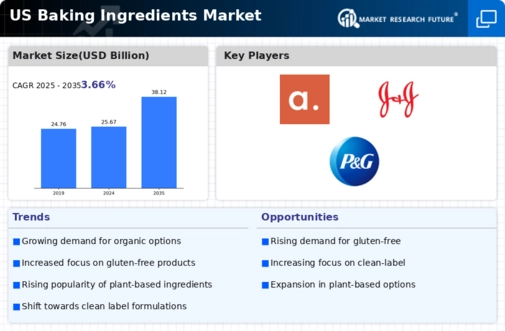Innovation in Flavor Profiles
Innovation in flavor profiles is a key driver in the baking ingredients market, as consumers seek unique and diverse tastes in their baked goods. The introduction of exotic flavors and ingredients, such as matcha and lavender, is gaining traction among home bakers and professional chefs alike. This trend is supported by market data indicating a 10% increase in sales of flavored extracts and specialty ingredients. As consumers become more adventurous in their baking endeavors, manufacturers are encouraged to develop new and innovative products that cater to these evolving tastes, thus fostering growth in the baking ingredients market.
Rise of Plant-Based Alternatives
The baking ingredients market is experiencing a notable rise in the popularity of plant-based alternatives. As more consumers adopt vegan and vegetarian diets, the demand for plant-based baking ingredients, such as almond flour and aquafaba, is increasing. Recent market analysis suggests that the sales of plant-based ingredients have surged by 30% over the past year. This trend not only caters to dietary preferences but also aligns with health-conscious choices among consumers. As a result, manufacturers are expanding their product lines to include a variety of plant-based options, thereby driving growth in the baking ingredients market.
Expansion of E-commerce Platforms
The baking ingredients market is witnessing a significant shift towards online shopping, driven by the expansion of e-commerce platforms. With the convenience of home delivery and a wider selection of products, consumers are increasingly purchasing baking ingredients online. Recent data indicates that online sales in the baking ingredients market have grown by 20% in the last year, reflecting changing consumer behaviors. This trend is particularly pronounced among younger demographics who prefer the ease of digital shopping. Consequently, traditional retailers are compelled to enhance their online presence, further propelling the growth of the baking ingredients market.
Increased Focus on Sustainability
Sustainability has become a pivotal concern for consumers, influencing their purchasing decisions in the baking ingredients market. There is a growing preference for ingredients that are sourced sustainably and packaged in eco-friendly materials. This shift is evident as brands that prioritize sustainability report a 25% increase in sales. Consumers are more inclined to support companies that demonstrate environmental responsibility, prompting manufacturers to innovate and adapt their practices. As sustainability becomes a core value for many consumers, it is likely to continue shaping the landscape of the baking ingredients market.
Growing Demand for Artisan Products
The baking ingredients market experiences a notable surge in demand for artisan and handcrafted products. Consumers increasingly seek high-quality, unique ingredients that enhance the flavor and texture of baked goods. This trend is reflected in the market, where the sales of specialty flours and organic ingredients have risen by approximately 15% over the past year. Artisan baking not only emphasizes quality but also aligns with the growing consumer preference for transparency in sourcing. As a result, manufacturers are adapting their offerings to include more artisanal options, thereby driving growth in the baking ingredients market.














Leave a Comment